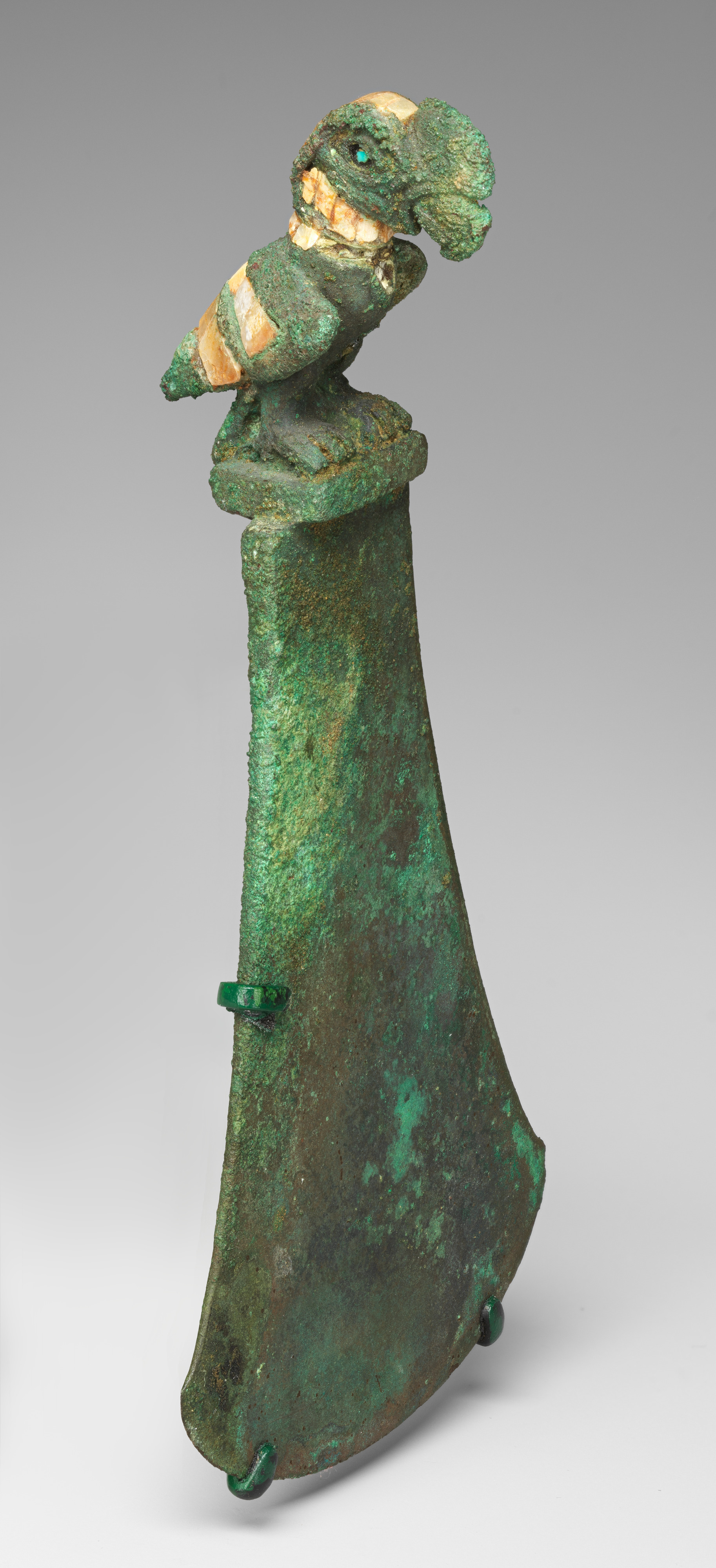Tumi (knife) with condor
With a wingspan of over ten feet, the Andean condor is one of the largest flying birds in the world. Artists, including those of the Moche culture on Peru’s North Coast, depicted this majestic creature in a variety of media. Its immense size and ability to tear away the flesh of its victims undoubtably placed this bird high in the Moche pantheon of powerful animals. Here, the metalsmith sculpted the form of a male condor (identified by the caruncle on the top of the beak) on the top of the handle of a tumi, a broad bladed ritual knife. This was then cast in copper using the lost-wax technique and various inlays were added, such as turquoise for the pupils of the eyes, and shell to indicate the patterning of the feathers.
The Moche (also known as the Mochicas) flourished between 200 and 900 CE, centuries before the rise of the Inca (Castillo, 2017). Over the course of some seven centuries the Moche built thriving regional centers from the Nepeña River Valley in the south to perhaps as far north as the Piura River, near the modern border with Ecuador, developing coastal deserts into rich farmlands and drawing upon the abundant maritime resources of the Pacific Ocean’s Humboldt Current. Although the exact nature of Moche political organization is a subject of scholarly debate—some believe it was a single, unified state, others suggest there were multiple polities—it is clear they shared unifying cultural traits such as religious practices (Donnan, 2010).
References and Further Reading
Bourget, Steve. Les rois mochica: Divinité et pouvoir dans le Pérou ancient. Paris: Somogy éditions d'art. Geneva: MEG: Musée d'ethnographie de Genève, 2014.
Castillo, Luis Jaime. “Masters of the Universe: Moche Artists and Their Patrons.” In Golden Kingdoms: Luxury Arts in the Ancient Americas, edited by Joanne Pillsbury, Timothy Potts, and Kim N. Richter, pp. 24-31. Los Angeles: J. Paul Getty Museum, 2017.
Disselhoff, Hans-Dietrich. “Metallschmuck aus der Loma Negra, Vicús (Nord-Peru).” Antike Welt, Zeitschrift fúr Archäologie und Urgeschichte 3, no. 2, (1972), pp. 43-53.
Donnan, Christopher B. “Moche State Religion.” In New Perspectives on Moche Political Organization, edited by Jeffrey Quilter and Luis Jaime Castillo, pp. 47-69. Washington D.C.: Dumbarton Oaks Research Library and Collection, 2010.
Jones, Julie. "Mochica Works of Art in Metal: A Review." In Pre-Columbian Metallurgy of South America, edited by Elizabeth P. Benson, pp. 53-104. Washington, D.C.: Dumbarton Oaks Research Library and Collection, 1979.
Kaulicke, Peter. “The Vicús-Mochica Relationship.” In Andean Archaeology III, edited by William H. Isbell and Helene H. Silverman, pp. 85-111. Boston, MA: Springer, 2006.
Lechtman, Heather, Antonieta Erling, and Edward J. Barry Jr. "New Perspectives on Moche Metallurgy: Techniques of Gilding Copper at Loma Negra, Northern Peru." American Antiquity vol. 47 (1982), pp. 3-30.
Ríos, Marcela and Enrique Retamozo. “Investigaciones sobre la metalurgia Vicús.” Gaceta Arqueológica Andina VII, no. 23 (1993), pp. 33-66.
This image cannot be enlarged, viewed at full screen, or downloaded.
This artwork is meant to be viewed from right to left. Scroll left to view more.



